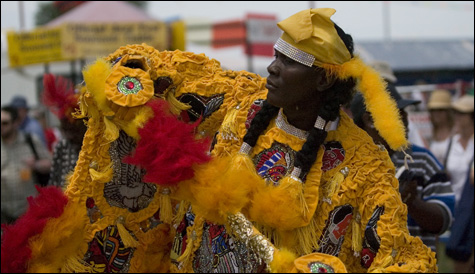
SHALLOW WATER: The big names draw the numbers, but it’s homegrown phenomena like the Mardi Gras Indians who give Jazzfest — and New Orleans — its soul.
|
This year as last, the refrain at the New Orleans Jazz & Heritage Festival was: “We’re back.” But the question still nagged: “How far ‘back’ are we? And when, if ever, will the city be able to restore the web of family and neighborhood connections that were smashed on August 29, 2005.” “Last night, for the first time since Katrina, my wife and I slept in our house,” Brice Miller of the Mahogany Brass Band declared in the midst of a raucous, celebratory set. He announced it as a personal triumph — and it was. His determination was inspiring. At the same time, it was dispiriting to realize that his personal odyssey had taken nearly two years. How many other New Orleanians can afford that time? And what if you have no house to come back to?
The statistics point to signs of life. The Times-Picayune reported that there’d been a 14 percent jump in population since July 2006. Another story talked about a possible classroom shortage this fall because of an expected increase in enrollment from 17,600 to 26,000 students. But 20 months after the storm hit, Orleans Parish stands at only 56 percent of its pre-Katrina population of 454,000.
Before Katrina, it was easy for a festivalgoer and tourist (I’m guilty on both counts) to ignore that this was one of the poorest cities in America, with one of the highest murder rates. Jazzfest, which is held at the Fair Grounds racetrack, and the French Quarter provide a cocoon. (This year I attended the first of the annual two weekends, last in April, first in May.) Jazzfest, after all, is an international event. This year’s headliners included the Allman Brothers, Counting Crows, Van Morrison, Nora Jones, Jerry Lee Lewis, Ludacris, Bonnie Raitt, Steely Dan, Lucinda Williams, ZZ Top, and, of all people, Rod Stewart.
But the soul of the festival has always been in the regional acts, the Cajun and zydeco musicians, the Mardi Gras Indians, the blues musicians, the one-hit R&B and swamp-pop stars — Clarence “Frogman” Henry and Frankie Ford — who never travel north of I-10. It took me years to realize — maybe too late — that New Orleans’s greatest music came from its most desperate neighborhoods. Born and raised in the Lower Ninth Ward, Fats Domino never left his neighborhood, even after he struck it rich, even after the flood swamped his house. He got out barely in time.
It’s a city of tribes: Mardi Gras Indians, housing projects (Magnolia, Calliope, Melpomene), neighborhoods (the Third Ward, the Lower Ninth, the Seventh, Desire, Gentilly). The music emerges from those tight networks of neighborhood and family. When I asked a sixtysomething white local-record-store owner about New Orleans hip-hop, he led me to his section of bounce mixes and said, “I’m friends with all these guys, but it’s a bit embarrassing because I know them through their fathers.” R&B and jazz musicians all.
If anyone speaks for those broken neighborhoods at Jazzfest now, it’s hip-hop’s fellow travelers — the Mardi Gras Indians, the brass bands. Last year, rapper Juvenile — son of the Magnolia project — made a triumphant appearance at the Congo Square stage in front of thousands. He drew the youngest and most racially mixed crowd of all the acts I saw at last year’s first weekend, tattoo’d white indie-rock kids and dreadlocked jam-band Rastas, young blacks in basketball T’s and big sneakers. Nonetheless, in a pre-fest article last year, the New York Times’ Kalefa Sanneh criticized the producers for mostly ignoring “the music that has been the city’s true soundtrack through the last few decades.”
Rap is still under-represented. This year, Atlanta’s Ludacris was the sole representative of hip-hop nation. He drew as massive a crowd as Juvenile’s, if not quite the homeboy exultation. But hip-hop entered through stealth — in the raps, the beats, and the long T’s and baggy basketball shorts of the brass bands, and in the chants of the Mardi Gras Indian tribes over second-line rhythms. Bounce has its source in those parade rhythms, and you know that rap isn’t new when you hear an elder Mardi Gras Indian in full feathered regalia freestyling his life story over the ancient call-and-response chant “Shallow Water”: “In 1996 they put me in jail/I had to go upstate.”
The writer Nik Cohn was sucked into those neighborhoods and the world of bounce, even trying his hand at record producing. His Triksta: Life and Death and New Orleans Rap is by turns hilarious, terrifying, and sad. The book was published last year, but a post-Katrina afterword in the paperback edition makes it newly essential. Cohn is unfairly dismissive of Jazzfest, but his fury over the mistreatment of the city’s poor and the destruction of its culture is eloquent. He speaks for a lot of us when he worries that New Orleans could become a Dixieland theme park. As a long-time New Orleans lover, he’s speaking with the pain of a broken heart.